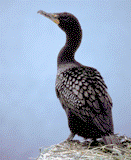United States Department of Agriculture, National Wildlife Research Center: Symposia

Symposium on Double-Crested Cormorants: Population Status and Management Issues in the Midwest
Date of this Version
December 1997
Abstract
In the early 1990’s, it became apparent that the rapid colonization of Tommy Thompson Park on Lake Ontario near Toronto by double-crested cormorants (Phalacrocorax auritus) would eventually affect the existing colonies of blackcrowned night-herons (Nycticorax nycticorax) owing to competition for nest sites and destruction of nest trees. As a result, monitoring of these two species was expanded in 1992 by individually marking all nest trees (using permanent metal tree tags) and by recording the numbers of heron and cormorant nests for all nest trees. In 1996, professional surveyors determined the exact locations of nest trees. We have developed a geographic information system (GIS) to plot the changes in the nesting distributions of cormorants and night-herons during 1992–97 on three peninsulas at Tommy Thompson Park. The GIS clearly illustrates the relationship between the expanding nesting areas of the cormorants and the receding nesting areas of the nightherons at the two shared colony sites. The GIS products will be helpful in any discussions of local cormorant management.

